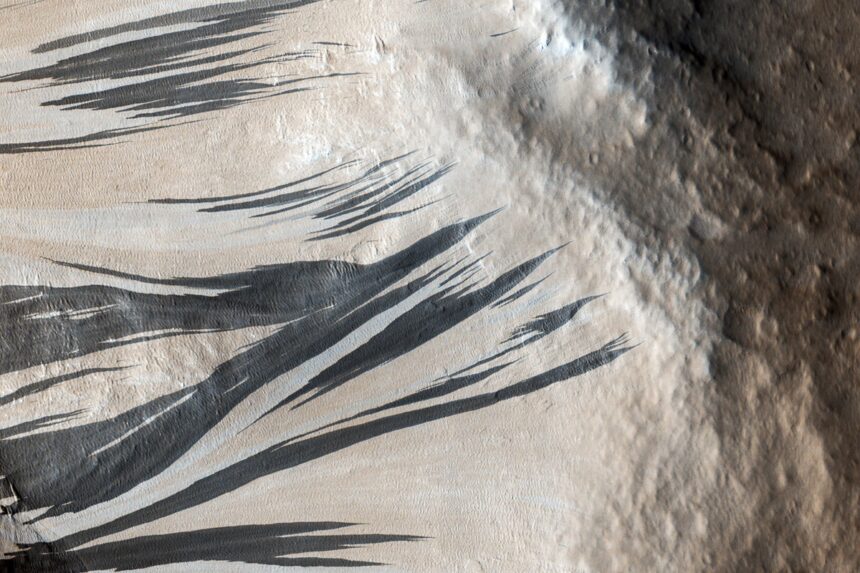For years, scientists have been looking for signs of liquid water just beneath the surface of Mars. The problem, though, is that the observations from various orbiting probes have been maddeningly ambiguous, sparking a lot of debate.
New research recently published in Nature Communications may have dried up one of the most intriguing lines of evidence for subsurface water: it found that long streaks of material on the sides of slopes and crater walls is likely not from seeping liquid but from disturbed dry dust.
Does it even make sense to look for liquid water anywhere on Mars? When we look to Mars today, we see a desiccated, frozen world. No liquid water exists aboveground, and what water we do find is frozen solid, mostly at the poles.
On supporting science journalism
If you’re enjoying this article, consider supporting our award-winning journalism by subscribing. By purchasing a subscription you are helping to ensure the future of impactful stories about the discoveries and ideas shaping our world today.
There’s tantalizing evidence of liquid water in the Red Planet’s distant past, however. Scientists have spied the sinuous courses of long-lost rivers, as well as the ancient shorelines of vanished lakes and seas carved in the world’s rocks, and minerals formed in aqueous environments are relatively commonplace on the surface.
That wet phase of Martian history was billions of years ago, however, and all that water has since evaporated away into space or seeped deep underground. But here and there on modern-day Mars, we still see what might be evidence for liquid water lurking just beneath the Martian surface.
One of the most perplexing hints of hydration are a handful of slope streaks: narrow, long and sometimes bright but usually dark features that are commonly located near the tops of crater walls and scarps. Many are straight, and some wind a bit, but they do very much look like what you’d expect if water leaked out from behind the slope and caused a small flow downhill.
These streaks were first discovered in Viking data from the 1970s. The images were low-resolution and fuzzy by today’s standards, but the advent of more advanced orbiters provided sharper views of these features. The streaks tend to be only a few dozen to a couple of hundred meters wide, but they can be a kilometer long. They’re seen in dusty equatorial regions and relatively persistent: once formed, they fade over years and decades.
In the late 2000s similar markings were discovered. Called recurring slope lineae (or RSLs), they look much like slope streaks but are usually found in rocky southern areas. They tend to fade over the course of a Martian year (which is about twice as long as our Earthly year) and recur annually in the same spots during summer in Mars’s southern hemisphere. RSLs are narrower than slope streaks, only a few meters wide, but also look very much like flow features.
Is this evidence of liquid water on Mars today? I remember, when these were first found, watching an associated NASA press conference and speculating with some colleagues that these could be from water frozen all winter but thawed by the spring and summer sun sending cascades of material downslope. It’s cold on Mars, well below water’s standard freezing point, but if the water were briny, it might stay liquid even in those frigid temperatures. (Salts are nature’s antifreeze.) And we do have plenty of evidence for water ice frozen just beneath the surface in many locations on Mars, even down to midlatitudes.
If RSLs really are triggered by water, they could be the best places to search for extant Martian life (and potential oases for any future human explorers as well).
That’s exciting! But is it true?
A problem with previous studies was the lack of a consistent, global database of streaks to investigate. To alleviate that issue, the authors of the new study examined more than 86,000 images from the Context Camera aboard NASA’s Mars Reconnaissance Orbiter. This instrument takes images of the Red Planet’s surface in long swaths about 30 kilometers wide. In the new study, the researchers used a machine-learning algorithm to find streaks in the images.
The algorithm identified about half a million streaks: roughly 13,000 bright and 484,000 dark. After accounting for streaks missed by the algorithm and other factors such as branching or overlapping streaks, the scientists estimate there could be as many as 140,000 bright and nearly two million dark streaks in the dataset. This is the first global, consistent database of Martian streaks, inviting deeper—and easier—analysis.
Next, the authors cross-referenced their streak database to others that instead track things such as temperature, wind and hydration across the surface of Mars. What they found supports a dry formation for RSLs and slope streaks alike.
For example, if the slope streaks are caused by sunlight-warmed water ice, you’d expect to find them forming overwhelmingly in slopes that face the sun. The researchers found only a weak tie to sunward-facing slopes, however. Another water-based expectation would be to find streaks where the temperature fluctuations are high, but instead they’re typically found in locations where temperatures are relatively stable. And although Mars isn’t exactly humid, there is some water vapor in the air, so streaks formed by wet cascades should occur mostly in slopes with higher humidity. But the study found them mostly in drier areas instead.
Interestingly, the more ephemeral RSLs do tend to favor sunward-facing slopes but, like the more longer-lived streaks, aren’t found in areas with high temperature fluctuations or levels of humidity, again implying they aren’t caused by water.
The scientists did find high correlations of slope streaks with regions that have higher wind speeds and lots of dust deposition—Mars is largely covered with a very fine-grained dust that’s high in iron oxide (rust), giving it its characteristic ochre coloring. These results point more toward a dry origin for the streaks. They are also found streaks near younger craters, where the ground is more disturbed and can trigger dust flows more easily. For instance, the researchers cataloged some streaks next to a fresh 140-meter crater that formed when a relatively small meteorite hit the surface of Mars just a few years ago. That location has steep slopes and quite a bit of dust; other craters with flatter slopes and less dust exhibit fewer streaks.
Interestingly, some fossae (Latin for “trenches”), locations where there may be ongoing underground volcanic activity, had streaks. The scientists didn’t find a correlation with marsquake activity, but in their paper they note that the data there are limited because of a lack of long-term seismometers on the planet.
Still, this implies streaks may be caused when a sharp energetic event happens on or near the surface, such as a quake or an impact that dislodges dust that then cascades down slopes.
While all this isn’t necessarily conclusive, a dry origin for the streaks does currently seem like the better bet. While that’s disappointing from the standpoint of looking for native life or supporting our own when we visit, it’s still an interesting result. The total estimated annual flux of dust from slope streaks suggests that they may move an amount of material equivalent to several global dust storms on Mars per year! (Actual global dust storms occur every few years on Mars.) These streaks are important geological features of the planet—and we should understand more about them before setting up shop there.
As for life on Mars, whether extant or eons dead, we’ll keep looking. Mars is dry now, but it was very likely once very wet, so hope springs eternal.








